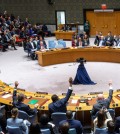- California Assembly OKs highest minimum wage in nation
- S. Korea unveils first graphic cigarette warnings
- US joins with South Korea, Japan in bid to deter North Korea
- LPGA golfer Chun In-gee finally back in action
- S. Korea won’t be top seed in final World Cup qualification round
- US men’s soccer misses 2nd straight Olympics
- US back on track in qualifying with 4-0 win over Guatemala
- High-intensity workout injuries spawn cottage industry
- CDC expands range of Zika mosquitoes into parts of Northeast
- Who knew? ‘The Walking Dead’ is helping families connect
Overseas Korean citizens victimized by crimes and accidents hit all-time-high
According to data released by S. Korean National Assembly Rep. Choi Jae-cheon
Overseas Korean citizens victimized by crimes and accidents have seen a 11.4-percent increase, from 4,458 cases in 2011 to an all-time-high 4,967 last year, according to data released Wednesday by South Korean National Assembly Rep. Choi Jae-cheon of the New Politics Alliance for Democracy party.
In that same period, 960 cases occurred in the United States, 253 died as a result of safety accidents, 85 were killed and 81 were victims of rape or other sexual assault.
Last year alone, there were 30 cases of murder, 82 cases of abduction or imprisonment, 252 cases of assault or injury and 320 cases of Koreans reported missing. Amidst these numbers, criticism is rising against Korean embassies and consulates overseas to facilitate better protection measures.
“The government has to strengthen its efforts to protect Koreans overseas as the number of crimes and accidents continue to increase,” Choi said.
Choi’s report emphasized the lack of protection Koreans overseas receive from the Korean government, in part due to the lack of established protection plans.
Asia and the Pacific regions saw the most incidents involving Korean citizens in the past three years, with 7,273 cases, followed by 5,516 in Europe, 960 in the U.S. and 271 in Africa and the Middle East.
On the other hand, Korean nationals who committed crimes and accidents overseas numbered 1,248 in 2011, 1,868 in 2012 and 1,432 in 2013, Choi’s report said.
A bill proposed after the start of the 19th National Assembly included the establishment of a safety committee for overseas Koreans affiliated with both embassies and the president and the preparation of funds for the protection of overseas Koreans in cases of incidents.
Others include having embassy consuls request fair protection and speedy aid to local investigatory agencies when needed and for embassy consuls to implement yearly protection plans.















